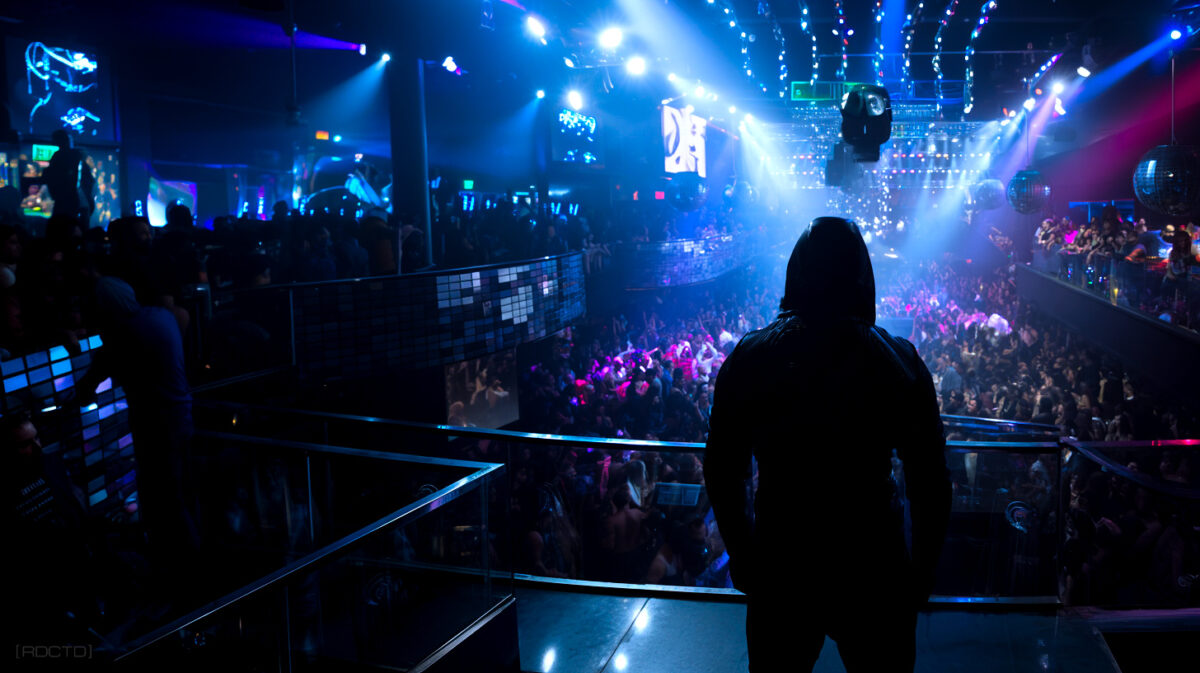 Situational awareness as per tradecraft in a nightclub setting is a particularly active, continuous perceptual process a covert operative uses to convert sensory chaos into a readable and usable operational picture.
Situational awareness as per tradecraft in a nightclub setting is a particularly active, continuous perceptual process a covert operative uses to convert sensory chaos into a readable and usable operational picture.An operator doesn’t out-shout the music, they read the rhythm of the room. Awareness begins where the bassline hides the tells.
Nightclubs are high-entropy environments that’s extremely loud, dim, kinetic, and deliberately disorienting. This means an operative’s starting task is to reduce uncertainty: define mission-relevant priorities (personal safety, egress methods, observation of persons of interest, or collection of behavioral baseline) and then bias attention toward those priorities.
That framing lets you trade off deep focus on a single target against a broader, looser scan of the space. Instead of chasing every anomaly, you direct your attention to the signals that map to your objectives. Allocating your cognitive bandwidth to gather what matters without burning out in the noise.
Landmarking // Pick three fixed points (such as the bar, the stage, and a stairwell) and keep them mentally anchored. This lets you reorient instantly if the crowd shifts or lighting changes.
[ LAYERS ]
![]()
Building strategic level awareness in a nightclub requires organizing your perception into structured layers, so the noise and chaos don’t overwhelm you.
Instead of taking in everything at once, you segment the environment into three operational tiers — macro, mezzo, and micro — each serving a different purpose (or as the venue requires).
This layered approach lets you process the scene in manageable slices and build a reliable mental picture of what’s happening around you.
![]()
Macro Layer / The Environment:
• Identify fixed elements – entrances, exits, stairwells, service corridors, bar layout, stage, and staff stations.
• Note moving elements – flow of people, crowd density, and natural traffic patterns through the space.
• Pay attention to choke points and open zones where people cluster or disperse.
![]()
Mezzo Layer / Group Dynamics:
• Observe where groups are forming and how tightly they’re bonded.
• Track how groups enter and leave — sudden departures can indicate conflict, coordination, or a triggering event.
• Note who is paired with whom, who’s leading interactions, and which groups attract staff attention.
![]()
Micro Layer / Individual Behavior:
• Watch for posture changes, head orientation, and repeated scanning behaviors.
• Note hand movements, particularly when they appear concealed, guarded, or held stiffly.
• Track sudden exits, unusually quick relocations, or other shifts that don’t match the established baseline.
![]()
To keep all three layers in play, cycle through them with brief, controlled sweeps. A 10–20 second scan of the environment followed by closer observation of individuals allows you to refresh your situational picture without fixating. The strategy here is balance: covering breadth while dipping into detail, always with your operational priorities guiding what you emphasize.
Crowd Energy // Learn the normal rhythm of the room, whether it’s music tempo or bar service pace. A sudden change in energy is often the first warning sign of a developing incident.
[ BASELINES ]
![]()
Behavioral baselining is the operative’s filter for separating signal from noise, threat from benign, opportunity from nonessential, and so on.
In a nightclub, much of what you see would appear erratic if judged in isolation – dancing, shouting, drinking, hugging, yelling, socializing, and random movement are all normal for the setting.
By first defining what “normal” looks like for that venue and moment in time, you create a reference point for real anomalies to stand out clearly.
![]()
Establishing the Baseline:
![]()
Recognizing Deviations:
![]()
Recording and Interpreting:
![]()
This discipline keeps you from overreacting to normal nightclub energy and directs your attention toward genuine anomalies. By resisting the urge to label behavior too early, you protect both accuracy and objectivity.
Staff Behavior // Bartenders and security see problems before anyone else. If their movement or demeanor suddenly changes, treat it as an early alarm.
[ RISKS ]
![]()
Every nightclub presents a set of environmental and human risk vectors that shape how an operative makes decisions – factors that aren’t optional to consider.
These are structural realities that either expand or restrict your ability to act. By understanding them in advance, you avoid being surprised when conditions shift against you. More importantly, this enables the ability to adjust your positioning, timing, and options accordingly.
![]()
Environmental Risk Vectors:
![]()
Human Risk Vectors:
![]()
Operational Adjustments:
![]()
By acknowledging both environmental and human constraints, you align your actions with the operational realities of the venue. Tradecraft here means working with the terrain, not against it, ensuring your awareness translates into safe, controlled, and effective decision-making.
Security Staff // Identify who’s working security and where they’re stationed. Their line of sight and body language often mirror the venue’s actual risk level.
[ COGNIZANCE ]
![]()
Cognitive tools and procedural tradecraft allow an operative to stay effective in a nightclub even when stress and sensory overload threaten to erode attention – as should be expected.
The goal is to reduce the mental load by using structured habits that run automatically, so you can keep awareness active without constant strain. A framework of checklists, spatial references, and communication protocols ensures your situational picture remains coherent and actionable.
![]()
Mental Checklist for Entry and Presence:
![]()
Memory Aids and Spatial Anchors:
![]()
Partner Communication Protocols:
![]()
These tools are to make observation more efficient while protecting your cognitive bandwidth under pressure. By standardizing procedures and reinforcing them with simple anchors, you free yourself to focus on higher-level decisions, ensuring your situational awareness stays both sharp and practical.
Drinks as Cover // Holding a drink in hand buys you a natural reason to stand still and observe. Opt for mocktails or don’t overindulge — your awareness is your edge.
[ FINAL ]
![]()
Convert perception into proportionate action. Awareness is about preserving options and timing decisions before issues become crises. Set clear thresholds for escalation: when you’ll reposition, when you’ll exit, when you’ll seek staff or medical help, and when you’ll disengage altogether. Always prioritize blending in, de-escalation, avoidance, and timing exits.
Nightclub situational awareness comes down to continuous scanning, fast pattern recognition, conservative decision thresholds, and clear, simple procedures that keep you effective without drawing attention.
![]()
// In a club, chaos is camouflage. Treat it as terrain and the cleanest path reveals itself.
[INFO : Bypassing The Line at Nightclubs]
[OPTICS : Ibiza, Spain]
![[RDCTD]](https://rdctd.pro/wp-content/uploads/RDCTD-Covert-Operative-Tradecraft-Guide-LOGO-tk.png)
![[RDCTD]](https://rdctd.pro/wp-content/uploads/RDCTD-Covert-Operative-Tradecraft-Guide-LOGO-mobile.png)






